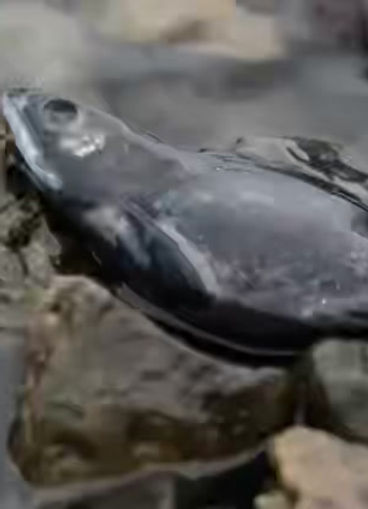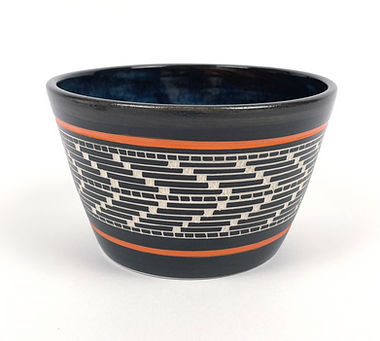

Patrick’s work is recognised for its fine finishing, colourful cloud-like glazes and bold, yet intricate weaving designs. His ceramics are of particular interest across North America as he is one of the only established First Nations potters working in the Pacific Northwest. Patrick's company P’egpig’7lha Studio & Gallery is based near Lillooet, BC and his work can be seen in both museum and commercial collections across North America.
At Edgelands, we are delighted to be the first gallery in Europe to represent Patrick and his work and we invite you to enjoy this beautiful collection of newly created vases and pots. Welcome to Patrick Leach: St’át’imc Ceramics from the Pacific Northwest.

Amy Wilson
Curator & Director, Edgelands
Roots
There are many plants which are of great importance to the Interior & Coast Salish Peoples of the Pacific Northwest and Patrick's roots vases reflect the vital role these plants play in the continuity of intangible and tangible cultural practices such as: canoe building, carving, weaving, saq̓úta (singing and dancing), medicine making and Indigenous Food Systems.
Plants are often viewed as relatives by many First Nations communities; and are respected as holders of knowledge and skills that teach us how to live well within biologically complex and ever changing landscapes. There are many powerful plants amongst the landscapes of the Snuneymuxw and St’át’imc territories that are delicious and potent such as th'uxhthuxh [stinging nettle] and the líl̓watǝmx, an edible wild onion after which the Líl̓wat First Nation is named.

The celestial bodies of the Sun, Moon & Stars are often found carved into the surfaces of Patrick’s ceramics. These designs are inspired by ancient pictographs [rock paintings] found in large concentrations near T̓ít̓q̓et where he was raised.




'St̓alhálam [Grizzly Bear] are a sacred relative of the St’át’imc Nation and are an important figure in St’át’imc creation stories; teaching communities how to survive and flourish in the mountainous landscapes of their home territories. St’át’imc cultural practices include many 'St̓alhálam songs, ceremonies and dances which share the wisdom of how to live well alongside others. As such, 'St̓alhálam are often seen as symbols of healing and strength. In collaboration with 5 other First Nations communities, St’át’imc First Nation actively works to sustain the wellbeing of local ‘St̓alhálam populations through The Grizzly Bear Translocation Project.
As well as earth pigments, dyes made from berries, fungi and plant roots (that are similarly deployed in the dying of natural fibres for Interior Salish basketry) were used to create materials suitable for painting on rock. Complex hunting and harvesting directions, the movement of the sun & moon, and a myriad of animals and plants; from the mountain goat, eagle and bear to the salmon and branches of the fir tree are depicted on these rocks. The areas where such pictographs are found are considered sacred sites by many First Nations communities as these rocks hold direct links to the lives of their ancestors; with pictographs often depicting events of great importance or information on how to navigate and survive within a particular local environment.

People of the Salmon


Salmon & Dip-nets
Salmon are a vital food source and a central part of the spiritual and cultural identity, wealth, health and continuity of Coast Salish & Interior Salish Peoples and their communities in the Pacific Northwest. For thousands of years the St’át’imc First Nation has fished Salmon along the Seton and Fraser Rivers; from the massive Chinnook to the colourful Sockeye and silvery Coho. Depicted here by Patrick in a style inspired by local pictographs, both salmon and dip nets can be seen in a winding pattern around the body of this bowl. The St’át’imc First Nation are well known for T’swan [wind-dried salmon] and fishing techniques such as dip netting. This is where a person perches precariously on the cliffside of a river and plunges a dip-net on a very long pole into deep and fast flowing water to retrieve salmon. Such fishing and preserving methods continue to be passed on from generation to generation and are used today alongside modern commercial harvesting methods.

[ sxwa7s ]
Salmon play a foundational role in the life of ecosystems throughout the Pacific Northwest, returning ocean nutrients to the rivers and streams where they were born, feeding wildlife, the waters and forests with their bodies and sharing life, knowledge and gifts with the humans they interact with.
In recent history, many factors have contributed to a rapid decline in the health and numbers of wild salmon in British Columbia. The introduction of open net-pen fish farms; impacts of climate change such as warming waters and fluctuating water levels; over fishing and agricultural runoffs; water pollution from mining and industry and the introduction of hydro electric dams along historic migratory routes have all played a role in this decline. In coalition with both Indigenous and settler communities, governments, organisations and businesses the St’át’imc First Nation play an important role in protecting Pacific Salmon from extinction.

Interior & Coast Salish Weaving

Basketry
Patrick’s body of work features an array of weaving patterns which take inspiration from both Interior Salish & Coast Salish basketry. The rhythmic flow of geometric designs around many of his vessels is often accompanied by the figures of salmon and elemental phenomena, and divided up by bands of colour in similar ways to traditional basketry.
Interior Salish & Coast Salish weaving is renowned for its astonishing intricacy and beauty and the knowledge of how to create vessels such as baskets for both ceremonial and practical use has been passed down through the generations for over 4,000 years.
Work by artists such as Patrick play a key role in upholding reverence for the power and wisdom held in basket weaving practices, his work (that brings together both design tradition and material innovation) aims to see these practices continue to survive and flourish into the future.


There are two main species of cedar trees, yellow cedar; known as pacelá7qw in Northern St̓át̓imcets and western red cedar; known as xhpey'ulhp in Island Hul'q'umi'num’. While xhpey'ulhp is most often found in the temperate rainforests close to the coast, pacelá7qw make their way further inland to also reside in subalpine habitats. The softer inner bark, roots and withes of both pacelá7qw and xhpey'ulhp can provide materials for clothing, hats, ropes, baskets and regalia such as headdresses and headbands. While the trunk and limbs can provide the materials for contemporary and traditional carving, creating a vast array of objects such as: tools, house posts, story poles, artworks and (as in the past) sea and river canoes and paddles. Their bows and leaves, are often burnt in ceremony by many Indigenous communities; the smoke generated acting to help cleanse, bless and protect people, objects and spaces. Medicinally, Cedar can aid the human body in reducing inflammation and infections. Their strength, straight grain and light weight also makes them ideal for building dwelling such as longhouses. The Interior and Coast Salish Territories are full of stunning examples of both traditional and contemporary architecture that showcase these trees versatility and beauty.
_-_(.png)

Cedar trees have a deep and abiding relationship with the lives of Indigenous Peoples throughout the Pacific Northwest; sharing knowledge, providing shelter, medicine, clothing and transportation for millenia. As such they are an integral part of cultural continuity.

There are 3 main types of basket weaving techniques in Interior and Coast Salish basketry; coiling, plaiting and twinning. The body of these baskets are most often made from a combination of different plant fibres; such as the inner bark or roots of the western red cedar, sprue roots and cattail leaves. Adornments in the form of decorative imagery and geometric patterns are created using plant fibres such as maiden head fern stems, horsetail roots and red cherry bark, as well as a host of different grasses often dyed to achieve a desired colour contrast. The knowledge of how to weave baskets comes with extensive mastery of how to gather, harvest and transform plants from one form into another; including the songs, ceremonies and protocols that are used to uphold sustainable and respectful relationships with these plants and the soil communities of which they are apart. Basket Weaving also draws upon a weaver's own distinctive lineage of aesthetic forms and imagery as well as the skills and creativity needed to express their own personal aesthetic styles and interests.

The Collection
Hummingbirds & Flowers
Called sxwut’ts’uli’ in Island Hul'q'umi'num' the hummingbird carries cultural significance for many Indigenous Peoples throughout the Pacific Northwest. Reflecting their energetic, resilient nature and stunning beauty, hummingbirds are commonly seen as symbols of joy and vitality and appear in oral histories as healers and as joyful messengers.
Featuring a pair of hummingbirds, basket weaving patterns, an expressive floral design and a bold bronze interior, this large bowl by Patrick makes a stunning statement piece.


In Interior and Coast Salish art, Hummingbirds are recognisable for their elongated, pointed beaks, a curl of feathers behind their head and their small light bodies. In British Columbia there are 5 species of hummingbirds found east of the Rocky Mountains 4 of which migrate as far as the South American Continent every winter. The Anna’s Hummingbird is an exception having evolved to survive the colder weather of the North.
Unceded, Ancestral & Traditional Territories of the Snuneymuxw & St̓át̓imc First Nations
Pacific Northwest



-ML-2_edited.jpg)
-blue-%230293-ML-1_edi.jpg)

-%230297-ML-1_.jpg)
-%230308-ML-2_edited.jpeg)




-%230309-ML-2_edited.jpg)
-%230308-ML-3.jpeg)
-%230332-350-ML-1_edited.png)












